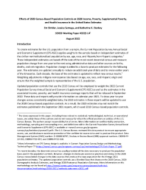
An official website of the United States government
Here’s how you know
Official websites use .gov
A .gov website belongs to an official government organization in the United States.
Secure .gov websites use HTTPS
A lock (
) or https:// means you’ve safely connected to the .gov website. Share sensitive information only on official, secure websites.
-
//
- Census.gov /
- Library /
- Census Working Papers /
- Effects of 2020 Census-Based Population Controls on 2020 Estimates
Effects of 2020 Census-Based Population Controls on 2020 Income, Poverty, Supplemental Poverty, and Health Insurance in the United States Estimates
Effects of 2020 Census-Based Population Controls on 2020 Income, Poverty, Supplemental Poverty, and Health Insurance in the United States Estimates
To create estimates for the U.S. population from a sample, the Current Population Survey Annual Social and Economic Supplement (CPS ASEC) applies weights to the sample based on independent estimates of the civilian noninstitutionalized population by sex, age, race, and Hispanic/non-Hispanic categories. These independent estimates are based off the date of the most recent decennial census and measure population change from one year to the next using administrative data and other sources on births, deaths, and net migration. Population change is added to a base to produce estimates for the following year. The estimates are updated annually to include an additional year of data and to revise earlier years of the timeseries. Each decade, the base of the estimates is updated to reflect new census results. Weighting adjustments mitigate nonresponse bias based on age, sex, race, and Hispanic origin and ensure that the weighted sample is representative of the U.S. population.
This paper demonstrates the effect of using the 2020 Census-based population controls on the 2020 data by presenting key income, poverty, Supplemental Poverty Measure, and health insurance estimates using both the 2010 and 2020 Census-based population controls.
Share
Related Information
WORKING PAPER
Health Insurance Working PapersWORKING PAPER
Supplemental Poverty Measure Working PapersSome content on this site is available in several different electronic formats. Some of the files may require a plug-in or additional software to view.
 Yes
Yes
 No
NoComments or suggestions?


Top

